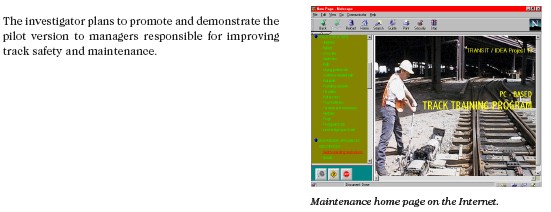|
The IDEA project developed multimedia tools for communication over the Internet to improve the education and training of transit track staff responsible for the day-to-day maintenance of track safety. Illustrated below is the Internet home page, which is presented in full color. The training program uses multimedia integrated with text, drawings, schematics, and blueprints that guide track foremen in theory, design, standards, procedures, and maintenance methods to identify and correct track defects. Specific contents of this pilot training software include
1. An instruction scope covering transit track roadway design, drainage, geometry, special work maintenance and component renewal/replacement, inspection for defects and in turnouts and frog welding and rebuilding.
2. Course modules that are self-paced and self-directed.
3. Voice and text integration providing the track worker with visuals, text, and audio guidance on how, when, and where to perform track maintenance action in the field.
The consortium of transit agencies participating in this course development effort include the Massachusetts Bay Transportation Authority (MBTA), New York City Transit/Staten Island Transit Authority (NYCT/SIRTOA), Port Authority Transit Corporation (PATCO), Southeastern Pennsylvania Transit Authority (SEPTA), and the Metropolitan Atlanta Rapid Transit Authority (MARTA). The MBTA tested the product before finalizing the software to confirm that voice, standards, and media will be effective. The American Railway Engineering Association (now AREMA) has supported this effort by allowing the use of elements of the AREA Manual and Portfolio of Trackwork Plans, and AREMA will receive a Web site link, assuring its continued participation in the implementation of this learning tool. Interest in this technology has been expressed by the MBTA, SEPTA, Washington Metropolitan Area Transit Authority (WMATA), NYCTA, AREMA, a few regional and short lines, the Polish State Railways (PKP), and several other railways internationally. NTIS # PB99-113193
The final report for this IDEA project can be found at:
https://onlinepubs.trb.org/onlinepubs/archive/studies/idea/finalreports/transit/Transit13_Final_Report.pdf.

|
|